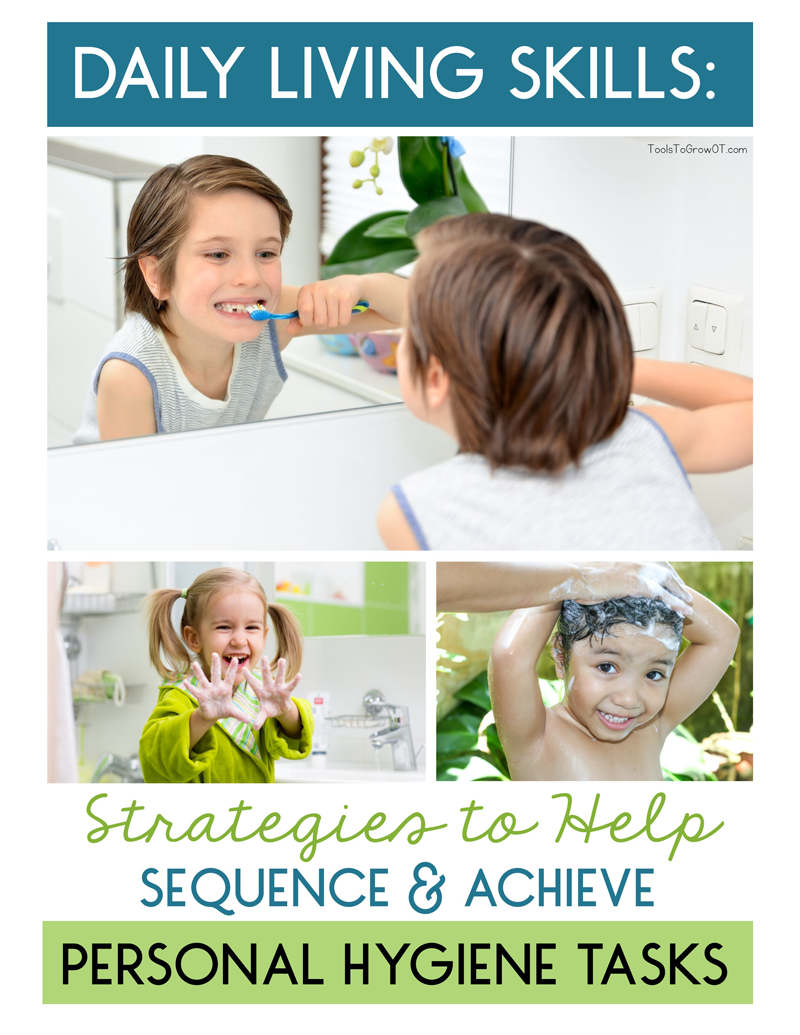Daily Living Skills: Strategies to Help Sequence & Achieve Personal Hygiene Tasks
08.09.2017
Self-Care and Daily Life Skills include some of the most important occupations children learn as they grow. These skills are encompassed in the child's Activities of Daily Living (ADLs) and Instrumental Activities of Daily Living (IADLs).
This blog will focus on ADLs and provide strategies to help a child sequence and execute personal hygiene tasks.

Basic Activities of Daily Living (also referred to as Self Care) skills include upper and lower extremity dressing, toilet hygiene and bowel/bladder management, bathing/showering, personal hygiene/grooming, eating/feeding, functional mobility, and sleep/rest.
Instrumental Activities of Daily Living (IADLs) occupations are more complex than ADL skills and are vital to children and young adults to prepare for independent living. These activities are needed to participate independently in home, school, community, and work environments. IADL skills include meal preparation, community mobility, health maintenance, home management (clothing care, cleaning), shopping, and care of others and pets.
Activity/Task Analysis
Occupational Therapy Practitioners, teachers, parents, and caregivers all share a common goal in regard to establishing, restoring, or maintaining a child’s ability to perform these daily living skills.
Each ADL and IADL involves a series of steps that are performed together in a specific sequence. A highly useful strategy to instruct children in the sequential performance of such tasks includes breaking down the task into smaller steps. While some children can observe others and readily reproduce the multi-stepped actions required to complete an ADL task, other children benefit from explicit instruction of each discrete step in the process. If the child struggles to complete any of the steps of the task, or complete a series of steps, the therapist may utilize different techniques tailored to suit each child’s learning style and ability. The process of “chaining” is a useful method in teaching ADL skills.
Methods of Teaching ADLs: Backward & Forward Chaining
Occupational Therapists are skilled at utilizing behavioral approaches, such as backward or forward chaining to teach daily living skills.
Backward Chaining involves the adult performing all the steps except the last step of the daily living task. In some cases, the child would require direct physical/personal assistance (hand over hand) for completion of the initial steps. The child is expected to perform the last step of the daily living sequence. As the child becomes more successful, he/she completes the last step and then the second last step. This continues with the adult performing fewer steps, and the child completing additional steps, until each step is completed independently. Backward chaining would be an appropriate approach to utilize when the child requires immediate feedback. This method is helpful for children with a low frustration tolerance or poor self-esteem, as it provides immediate success.
Forward Chaining involves the child completing a daily living task in the traditional pattern, executing the first step, then second step, and so on, until the sequence is completed. Forward chaining is beneficial for children who have difficulty generalizing activities. The adult is able to provide varying amounts of prompts and cues both before and throughout the task.
Visual Supports to Promote ADL Success
An environmental or task cue that can be utilized in sequencing personal hygiene skills is the use of visual pictures. Visual sequencing images allow for increased independence and success with daily living skills.
Utilizing pictures and/or words as an aid for learning will prompt the child through the entire sequence. These visual supports are especially useful when an adult is not present to support the learning process. The child can use the visual sequence images to help recall the steps of the sequence. Once Self-Care routines and patterns have been developed, it is important to maintain these skills by utilizing the supports that promote continued success. The development of routines and repetition are especially beneficial to children who have poor memory skills, thrive on routine, and/or need a prolonged period to learn new skills.
NEW Personal Hygiene Resources!
Tools to Grow is pleased to present the following NEW Activities of Daily Living Resources! This is a HUGE collection of personal hygiene resources!!
Categories/Hygiene Topic Areas Include:
2. Showering
4. Showering Without Hair Washing

Each of these four Activity of Daily Living Topic Areas include the following resources:
(1) Sequence Strip,
(2) Cut and Paste Activity,
(3) Visual Cards, and
(4) Checklists for Documenting/Monitoring Progress.
Each resource will be discussed separately below.

(1) SEQUENCE STRIPS:
Purpose: These strips visually depict the daily living sequence. These visuals can be utilized to help a child recall and implement each step in an orderly manner for optimal success. Use these in the school or home setting. Great for young and older children that benefit from a reminder/visuals for learning. Each sequence strip is easy to see and understand.
Instructions to Print: Print out on heavy cardstock, paper, or laminate. Includes Different Versions so that you can customize and select the appropriate version for your child:
- With Visuals, Numbers, and Words
- With Visuals and Words
- Visuals only with blank outline – Customize Your Own Sequence!
1. Brushing Teeth - FREE Version found here!!!
2. Showering
3. Washing Hands
4. Showering Without Hair Washing

(2) CUT AND PASTE ACTIVITY:
Purpose: This cut and paste activity is a great exercise to sequence and learn the daily living process outside of the bathroom setting. Great activity to complete with a group!
Instructions to Print: Each child will require one “Visuals Page” and one “Blank Grid”. Includes Different Versions of “Visual Page” so that you can customize and select the appropriate version for your child:
- With Visuals, Numbers, and Words
- With Visuals and Words
Instructions to Complete Activity:
- Select appropriate version for individual child.
- Child cuts out each individual square that depicts a single step.
- He or She then glues each square/step in the appropriate order to sequence the given daily living task.
Find these Cut & Paste Sequencing Activities Here!

Purpose: These sequencing cards are a great way to learn and visualize the daily living sequence. The larger size makes them easy to see and manipulate for learning.
Instructions to Print: Print out on heavy cardstock, paper, or laminate. Includes Different Versions so that you can customize and select the appropriate version for your child:
- With Visuals, Numbers, and Words
- With Visuals and Words
- With Visuals
Instructions to Complete Activity:
- Select appropriate version for individual child.
- Cut out each individual card.
- Punch a hole in each card.
- Place in the appropriate order to sequence the steps of the daily living routine.
- Place cards on a ring.
Alternate Activity:
- Place the cards in a random order.
- Encourage your child to organize pile in the proper order.
- The child can arrange in a vertical column, horizontal row, or top to bottom in a pile.
Purpose: These checklists are the perfect solution to document progress and intervention when teaching personal hygiene skills.
Each checklist includes each step of the given hygiene task with an area to record the date and level of assistance needed. Also includes a marking key.
FREE Showering Checklist found here!
Find all Daily Living Skills Checklists Here!
![]()
We hope these Personal Hygiene tools, tips, and specialized resources will allow for simplification, repetition, modification, and extra reinforcement to help the children in your life achieve success when learning ADL skills.
Find more ADL/Self Help Blog Posts here! Topics Include:
- Shoe Tying: Tools, Tips, and Resources to Help Children
- Improving Your Child's Executive Functioning Skills at Home
- Tips & Strategies to Help Children with Poor Tolerance for Tooth Brushing
- Social Stories
Find more ADL Resources here! Resources Include:
- Beat the Clock Dressing Game!
- Clothing Mix Up!
- Clothing Sort
- Meal Time: Snack Mats
- Dress Up Paper Doll
Find IADL Resources here! Resources Include:
- Calendar Practice
- Chore Checklist
- Healthy Meal Planner
- Draw a Picture of Your House
- Let’s Learn my Phone Number
- Menu, Meal Planner, & Grocery List
- Mixed Up Grocery List
- Let's Go to the Market! A Working Memory Game
Find Routine Charts here!
- After School Routine Chart
- Daily Routine Chart
- Good Night Routine Chart
- Good Morning Routine Chart
- Potty Routine Chart
Related Topics: Documentation & Data Collection, Self-Help/Life Skills, Tools to Grow at Home , Tools to Grow at School



